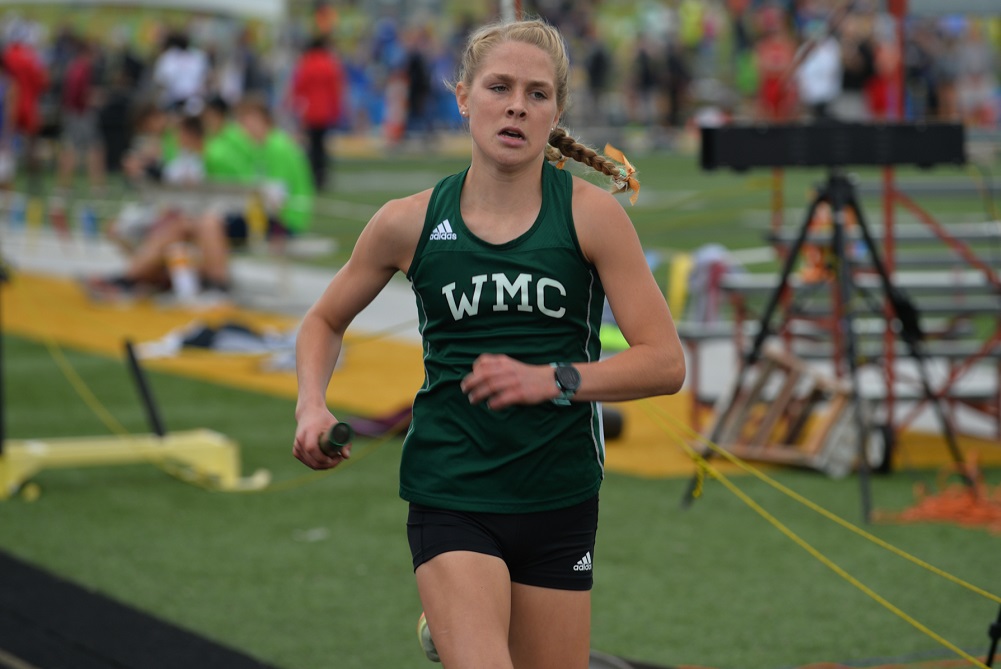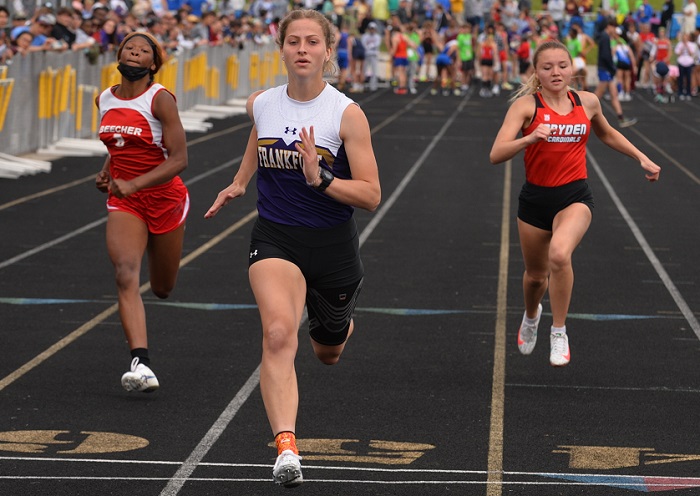
VanderKooi & Friends Deliver Western Michigan Christian's 1st Track Title
By
Drew Ellis
Special for MHSAA.com
June 4, 2022
HUDSONVILLE – Abby VanderKooi just needed a little help from her friends.
The Muskegon Western Michigan Christian senior distance runner convinced her friends, volleyball standouts Kyla and Maddie Wiersema, to join the track team in their senior year to give WMC an added boost at the end of the season.
At Saturday’s Lower Peninsula Division 4 Finals, Kyla scored in three events, while Maddie scored in two. That, combined with VanderKooi scoring in four of her own, gave the Warriors the lift they needed to win their first track & field Finals title, posting 52 points to finish just ahead of 2021 champ Mount Pleasant Sacred Heart, which scored 48.
“They’ve been friends since they were little kids, so they decided to come out this year,” WMC coach Greg Gould said of the Wiersema twins and VanderKooi. “We knew they were super talented and just added a lot to this team. To see them perform so well (Saturday) and help this small team of athletes win a state title is pretty incredible.”
VanderKooi herself had a big day, setting an LPD4 Finals record in the 3,200-meter run with a time of 10:49.25. It was her third time winning a Finals title in the event to go with four cross country state titles as well.
She also finished second in the 1,600, fourth in the 800, and was part of the 3,200 relay team that finished second.
“Today wasn’t about me, it was about what I could do for my team,” VanderKooi said. “I’m really happy with my performances, but I’m most excited about what we’ve been able to do as a team.”
The Irish had a big performance from senior Nicole Olivieri, who won the 200 in a time of 26.37, then set an LPD4 Finals record in the 400 with a time of 56.01. She was also the anchor leg of the winning 800 relay team (1:49.21) and the runner-up 1,600 relay squad.
“I was pretty tired after that 400, but I knew my team was depending on me for points in the 200, so that gave me a little more push,” Olivieri said. “(The 400 record) has been my goal since missing it by 0.18 seconds last year. That .01 was tough, but I can’t be mad. It’s an amazing accomplishment for me.”
 Olivieri’s teammate, Anna Plum, came away with the championship in the 300 hurdles with a personal-record time of 47.03.
Olivieri’s teammate, Anna Plum, came away with the championship in the 300 hurdles with a personal-record time of 47.03.
Frankfort finished third on the day with 39 points, thanks largely to senior Tara Townsend.
Townsend collected her third pole vault state title with a leap of 11-6. She attempted to set an LPD4 Finals record of 12-1, but just couldn’t quite get over the bar.
“It was a little disappointing because I went 12 last year and I wanted to go higher, but I can’t really be too disappointed,” Townsend said of her vault performance. “I just took a deep breath on the last one and gave all I had.”
Townsend followed up her pole vault title by winning the 100 dash championship in a time of 12.79. She also was the anchor leg of the winning 400-meter relay team (51.87), while placing third in the 200 dash. Not bad while dealing with a hamstring injury in the process.
Buckley sophomore Aiden Harrand had an impressive day, as she took home titles in the 800 and 1,600 runs. In the 800, Harrand had a PR of 2:19.25, while she finished the 1,600 in a PR of 4:56.38.
Fowler won the 1,600-meter relay with a time of 4:10.11 to close out the meet. The Eagles came in fourth as a team with 35 points. Rochester Hills Lutheran Northwest won the 3,200 relay with a time of 9:59.16.
Brynn Mericle won the 100 hurdles with a PR time of 15.93 to spark East Jackson to a fifth-place finish as a team.
In the field events, Morrice senior Emma Valentine repeated as the LPD4 high jump champion with a leap of 5-6.
“It was very nerve-wracking, because I wanted to repeat but I wasn’t sure how the day would pan out,” Valentine said. “I was very excited to be able to clear (5-6) again. It was great to be able to show up and perform well.”
Hillsdale Academy’s Anna Roberts took home the long jump title with a jump of 16-5.5. Gobles’ Elli Stender won the discus with a PR toss of 122-9. Kalamazoo Christian’s Tess VanDyk repeated as champion of the shot put with a throw of 41-7.
PHOTOS (Top) Muskegon Western Michigan Christian's Abby VanderKooi runs her leg of the 3,200 relay Saturday at Baldwin Middle School. (Middle) Frankfort's Tara Townsend, middle, wins the 100. (Click for more from Dave McCauley/Run Michigan.)

Track Gaining Speed Toward Future with Electronic Starting Devices
By
Steve Vedder
Special for MHSAA.com
May 23, 2023
Aubrey Greenfield thinks it might be the perfect time to reevaluate 130 years of tradition.
For a number of reasons, from technical to personal, the Oxford senior sprinter believes it makes sense for the crack of a starting pistol to be eliminated from high school track meets.
Because track meets would benefit in various ways from lowering costs to easier setup at meets to the human factor of competitors not having to flinch at the crack of a pistol shot, Greenfield believes the sport has a chance to embrace new technology – electronic starting devices (ESD).
In essence, an ESD replaces the starting pistol with a light flash, tone sound or both to begin a race.
"High school sports should put the athlete first," Greenfield said. "We should promote sports, and eliminating starting pistols promotes health in terms of PTSD or trauma for athletes and spectators and that would be good. I would like to think people would say that's a good idea."
In fact, Greenfield would go as far as to say if there was not an implementation of electronic starting devices, many of her teammates would have considered giving up the sport.
"If it's something that helps us compete safely, we're all for it," she said.
Greenfield's opinion apparently is spreading. Michigan High School Athletic Association senior assistant director Cody Inglis said the use of ESD makes it both affordable for meet starters and sensible for athletes and fans to rethink the use of starting pistols. While the MHSAA is not mandating electronic starting devices, it does promote the use of what Inglis calls "emerging technology." He notes that ESD are becoming the norm for organizations such as USA Track & Field, the NCAA and an increasing number of high schools.
 "I think we have to embrace new technology, and we think this will be something that takes hold," Inglis said.
"I think we have to embrace new technology, and we think this will be something that takes hold," Inglis said.
A key part of embracing ESD is the human element. The tragic Oxford High School shooting Nov. 30, 2021, that took the lives of four students while injuring seven others should not be relived even for a fleeting instance at a high school sporting event. Oxford athletic director Tony DeMare said the school began using ESD at every meet, including the MHSAA Lower Peninsula Division 1 Finals last June. He said that decision was embraced by virtually all schools Oxford encountered.
"We were very convinced that the alternative (of ESD) would promote a healthy attitude," DeMare said. "We were overwhelmed with the positive response. If a school was on the fence about it or might not be for it, I think we've started to see the tide turn in favor of people willing to listen and learn about electronic starting devices."
Inglis said the MHSAA is acutely aware of what the crack of a starting pistol can mean to athletes and fans.
"It's unimaginable what Oxford went through, and this is a small way we can help," he said. "We look at a (starting pistol) and think, ‘Could we do something else?’ It's a way of helping to solve a problem."
Over the last several years, the MHSAA has embraced finding an alternative to starting pistols. Inglis noted the discussion started with the cost and diminishing availability of 32-caliber ammunition that meet starters use. A box of ammunition, if it can be found, is around $75 a box.
In addition to cost, there is potential damage from excessive exposure to 150-plus decibels of sound generated by the traditional 32-caliber blanks. Medical studies show damage to ears caused by decibel levels above 120 dB.
The tragedy at Oxford accelerated the conversation.
Inglis said the cost of ESD can be likened to a school sinking money into artificial surfaces at football fields. Yes, there is a great cost at first, but over time money is ultimately saved. An ESD system itself ranges between $200 and $500. Speakers also may need to be purchased, but with ESD starting events like the 800 and 1,600-meter relays positioned near the outside lanes 8, 7, 6 and 5 would result in improved hearing by athletes at the start of a race.
There is one challenge with ESD that track administrators are working to overcome – lighting conditions that lessen the ability to see the ESD’s LED light or strobe when the button is pressed by a starter to begin a race. But that vision difficulty resulting from clear blue skies and backgrounds of setting suns can be substantially improved by incorporating a black background with an ESD – something as simple as a starter holding up black cardboard behind the lighting mechanism at the start of an event.
Inglis said when all factors are considered, the use of ESD makes sense.
 "With the climate we live in nowadays, no lookalike guns is good," he said. "We're not mandating this. But people are saying this is affordable."
"With the climate we live in nowadays, no lookalike guns is good," he said. "We're not mandating this. But people are saying this is affordable."
While switching to ESD would break 130 years of tradition, the timing could be a step forward, said Jeff Hollobaugh, co-author of the book "The Fleet Feet of Spring: Michigan's High School State Championships in Track & Field." He said while no definitive answer is possible, it's likely starting pistols were used at the inaugural state meet at the Jackson Fairgounds in 1895. The meet, which included events like tossing a 16-pound shot put, bike races and a 100-meter sprint, was sponsored by the Michigan Interscholastic Athletic Association (a predecessor to the MHSAA) and comprised mostly of the state's larger schools.
Hollobaugh's sentiments echo what many involved in today's high school track & field believe in terms of making a transition from starting pistols to electronic starting devices.
"It's a change, not necessarily good or bad, just different," he said. "It's not a drastic change, but it will take some getting used to. But it is the future. In the end, we'll all be fine."
DeMare believes the future of high school track will definitely include ESD.
"Our desire is that the practicality and sensibility of this will overcome the alternative," he said. "I think we'll see the automation and electronics taking hold of certain elements in track, and people will embrace it."
PHOTOS (Top) Runners watch official Bertha Smiley as they prepare to begin a race during last season's Lower Peninsula Division 1 Finals at Rockford. (Middle) An electronic starting device provided by VS Athletics was used to start those races. (Below) Smiley sets to begin an event. (Photos provided by David Kuderka/VS Athletics.)

